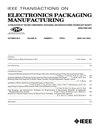Flip Chip Bonding of 68 $\times$ 68 MWIR LED Arrays
IEEE Transactions on Electronics Packaging Manufacturing
Pub Date : 2009-01-01
DOI:10.1109/TEPM.2008.2005062
引用次数: 12
Abstract
The flip chip bonding process is optimized by varying the bonding pressure, temperature, and time. The 68times68 mid wave infrared (MWIR) LED array was hybridized onto Si-CMOS driver array with same number of pixels. Each pixel has two indium bumps, one for cathode and another for anode. Both LED array and CMOS drivers have 15-mum-square Indium bump contact pads. We used Karl Suss FC150 flip chip machine for bonding of CMOS driver array onto LED array. From the LED current-voltage characteristics, it is concluded that the optimized flip chip bonding process results in uniform contact and very low contact resistance. Both electrical and optical characteristics of LED array after flip chip bonding are presented.68美元× 68 MWIR LED阵列的倒装键合
通过改变键合压力、温度和时间,优化了倒装芯片键合工艺。将68times68中波红外(MWIR) LED阵列杂化到相同像素的Si-CMOS驱动阵列上。每个像素有两个铟凸起,一个用于阴极,另一个用于阳极。LED阵列和CMOS驱动器都有15平方微米的铟碰触垫。我们使用Karl Suss FC150倒装机将CMOS驱动阵列键合到LED阵列上。从LED的电流-电压特性来看,优化后的倒装片键合工艺可以获得均匀的接触和极低的接触电阻。介绍了倒装键合后LED阵列的电学和光学特性。
本文章由计算机程序翻译,如有差异,请以英文原文为准。
求助全文
约1分钟内获得全文
求助全文

 求助内容:
求助内容: 应助结果提醒方式:
应助结果提醒方式:


